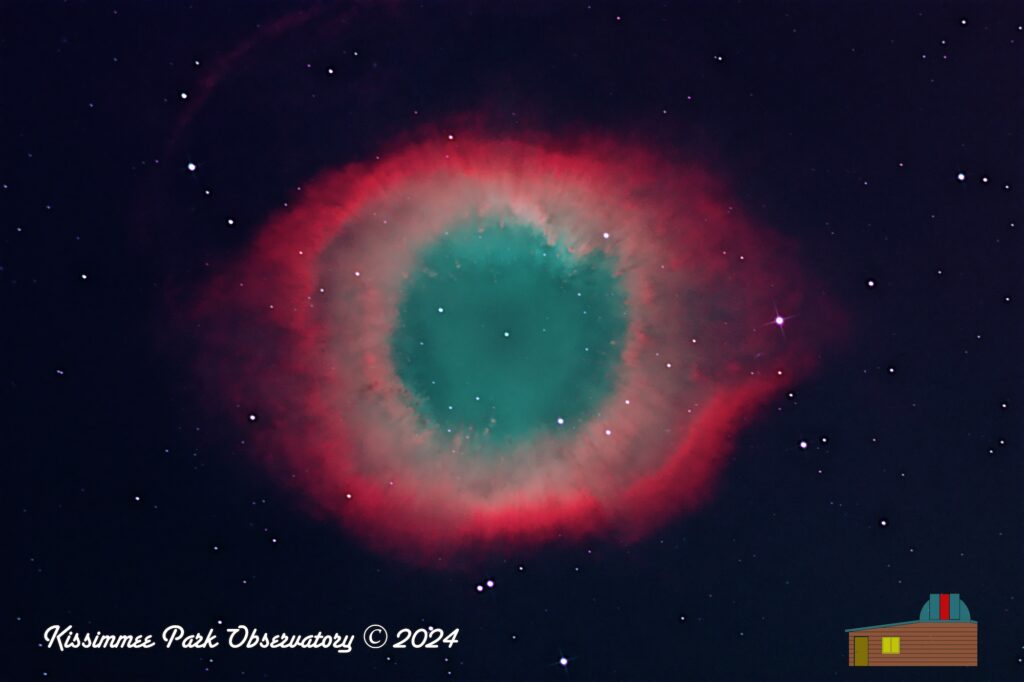
The Helix Nebula, NGC 7293, as captured by the KPO RC-12 astrograph. Total exposure time in this narrowband HOS image is 8.4 Hours.
The Helix Nebula: A Cosmic Masterpiece
In the vast canvas of the cosmos, where art and science blend seamlessly, there exists a marvel that captures the imagination of all who gaze upon it: The Helix Nebula, known scientifically as NGC 7293, and poetically dubbed “The Eye of God.” This nebula, located about 700 light-years away from Earth in the constellation Aquarius, is one of the closest and most spectacular planetary nebulae known to us.
The Formation of a Cosmic Eye
A planetary nebula, despite its name, has nothing to do with planets. Instead, it marks a late stage in the life of a star like our Sun. When a star has exhausted most of its nuclear fuel, it sheds its outer layers into space, forming a glowing shell of gas and dust. The Helix Nebula is the result of such an event, where a central white dwarf star, the core remnant of the original star, illuminates the ejected outer layers, creating a spectacle of light and color.
The Structure and Beauty of NGC 7293
The Helix Nebula is not just any planetary nebula; it’s unique in its complexity and structure. Here are some fascinating details:
-
Appearance: From afar, it might look like a simple ring, but closer observations reveal intricate details. The nebula is composed of knots and filaments that resemble a giant eye, with the central star acting as the pupil.
-
Color Palette: The nebula glows in a palette of green, red, and blue due to the emission of different gases. Oxygen emits a greenish hue, hydrogen glows red, and nitrogen adds a bluish tint.
-
Size: Spanning about 3 light-years in diameter, if we could see it in our sky, it would be about as wide as four full moons lined up side by side.
Scientific Insights from the Helix Nebula
Beyond its aesthetic appeal, the Helix Nebula offers valuable insights into stellar evolution:
-
Comets and Dust: Recent observations suggest that the nebula might contain billions of comets, remnants of the original star’s planetary system. This finding hints at the fate that might await our own solar system’s comets when the Sun reaches a similar stage.
-
Evolution of Stars: By studying the Helix, astronomers learn more about the death of stars and the creation of new elements, which are crucial for the formation of new stars and planets.
-
Cosmic Recycling: The material expelled by the star enriches the interstellar medium, providing the raw materials for future generations of stars and planets, illustrating the cycle of cosmic life and death.
Cultural Impact
The Helix Nebula’s nickname, “The Eye of God,” reflects not just its appearance but also its impact on human culture. It’s a symbol of the universe’s vastness, beauty, and the interconnectedness of all things. In art, literature, and philosophy, such celestial wonders often inspire contemplation on our place in the universe, our origins, and our future.
Stargazing the Helix Nebula
For amateur astronomers or those with a keen interest in the night sky, the Helix Nebula is a challenging but rewarding target. It’s visible through small telescopes as a faint, ghostly ring, but larger telescopes reveal more of its structure. Autumn nights in the Northern Hemisphere or spring in the Southern are prime times to spot this nebula.
Tap on the image to see a larger version you can explore.
Image Info
- Imaged at KPO, Saint Cloud, FL
- Camera : ZWO ASI2600MM Pro
- Scope: Orion 12″ Ritchey Chretien Astrograph
- Mount: iOptron Smart-EQ Pro
- Hydrogen Alpha: 39 subframes of 300s = 195 min integration
- Oxygen III: 36 subframes of 300s = 180 min integration
- Sulfur: 26 subframes of 300s = 130 min integration
- Total integration time: 505 min = 8.4 hours.
- Captured via ASIAir Pro automation
- Optical tracking via ASIAir automation via the ASI174mm Pro guide camera
- Separate channels stacked and HOS integrated in Astro Pixel Processor
- Image run through Super DeNoising
- Final processing in Aperture
